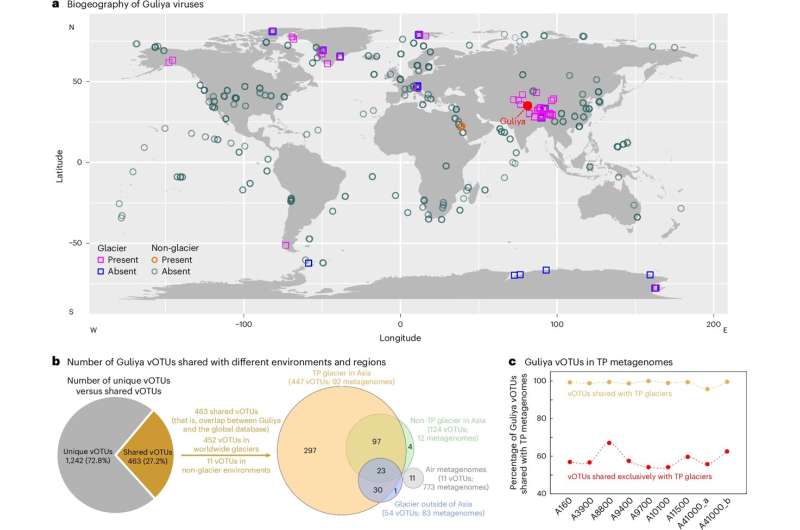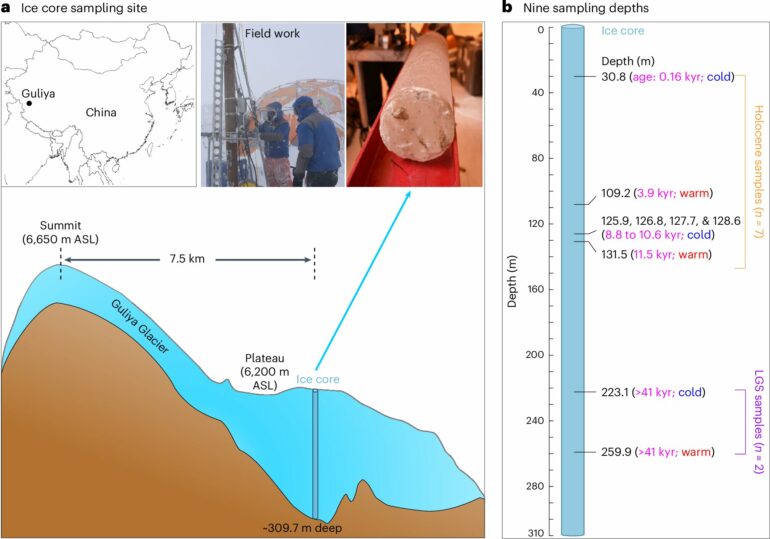Ancient viruses preserved in glacial ice hold valuable information about changes in Earth’s climate, a new study suggests.
For decades, the Guliya Glacier, located above 20,000 feet in the far northwestern Tibetan Plateau, has been one of the richest archives available to scientists to investigate large-scale paleoclimate shifts. Now, by analyzing recovered ice core samples from the glacier, microbiologists have reconstructed pieces of virus DNA that were left within them and identified nearly 1,700 viral species, of which about three-fourths are newly discovered.
Drilling into prehistoric ice doesn’t have health implications for modern humans, because these long-dormant viruses likely infected other dominant microbes rather than animals or humans, but researchers found that their adaptations significantly influenced their hosts’ ability to survive in extreme conditions during variations in Earth’s climate cycles.
“Before this work, how viruses linked to large-scale changes in Earth’s climate had remained largely uninvestigated,” said ZhiPing Zhong, lead author of the study and a research associate at the Byrd Polar and Climate Research Center at The Ohio State University. “Glacial ice is so precious, and we often don’t have the large amounts of material required for virus and microbe research.”
As unprecedented warming continues to hasten glacier melt, the race to collect these ice cores before they disappear for good has only served to increase their scientific value. For instance, the layers of ice researchers examined in this paper provided pristine snapshots of how viruses behaved during three cold-to-warm periods over the last 41,000 years.
The study was published today in Nature Geoscience.
Of the various types of new viruses reported, the most distinct viral community the team observed dates to about 11,500 years ago, a time during which a major climate transition from the cold Last Glacial Stage to the warm Holocene occurred.
This suggests that microorganisms were reacting to climate changes as global temperatures shifted from cool to warm, but it is still too early to say for certain, said Zhong. “This at least indicates the potential connection between viruses and climate change,” he said.

Biogeography of Guliya viruses. © Nature Geoscience (2024). DOI: 10.1038/s41561-024-01508-z
Using advanced sequencing technologies to get a closer look at their genetic signatures, the team’s results also showed that although most of the viruses found in the glacier were unique to Guliya, about one-fourth overlapped with known organisms from other areas of the world. “That means some of them were potentially transported from areas like the Middle East or even the Arctic,” said Zhong.
Taking the time to better understand how viruses evolved during intense climatic eras offers vital insights into predicting how modern viruses are likely to react to and engage with future ecosystem warming, researchers say. Moreover, because organisms found in ice cores expand the diversity of information researchers can learn about those periods, finding and sequencing new swaths of ancient viral DNA could lead to an explosion of both new mysteries and new conclusions.
“To me, this science is a new tool that can answer basic climate questions that we couldn’t have answered otherwise,” said Lonnie Thompson, co-author of the study and a professor in earth sciences at Ohio State.
Sharpening these techniques on Earth will likely provide scientists with fresh tools to broaden the search for life in outer space environments, aiding efforts to find microbes in the ice fields on Mars or underneath the icy shells of other planetary bodies, said Thompson.
Investigators looking to make further viral and climate connections here on Earth could also benefit from upcoming advances in technology as well as diverse scientific approaches to research, the study notes. Yet, the authors asserted, the clock is ticking: These techniques must be implemented before warming compromises the glacial ice needed to preserve and further explore Earth’s rich history.
“I’m optimistic about what can be done here, because if we work together, these techniques have much potential to help us start tackling a large array of scientific issues,” said Thompson.
Matthew Sullivan, co-author of the study and a professor of microbiology and civil, environmental and geodetic engineering at Ohio State, said the study’s success can be attributed to how well the interdisciplinary approach taken by Ohio State’s Byrd Polar and Climate Research Center and the Center of Microbiome Science has helped incubate new science.
“This kind of opportunity represents several disciplines coming together, each with their own scientific languages as a barrier to proceed,” he said. “But getting to study ancient viruses and microbes in ice with this team is a testament to the support we had to explore new interfaces.”
Other co-authors include Ellen Mosley-Thompson, Olivier Zablocki, Yueh-Fen Li and Virginia Rich of Ohio State, as well as James Van Etten of the University of Nebraska.
More information:
Zhi-Ping Zhong, Glacier-preserved Tibetan Plateau viral community probably linked to warm–cold climate variations, Nature Geoscience (2024). DOI: 10.1038/s41561-024-01508-z. www.nature.com/articles/s41561-024-01508-z
Provided by
The Ohio State University
Citation:
Locked in a glacier: Virus adaptations to extreme weather provide climate change insights (2024, August 26)



